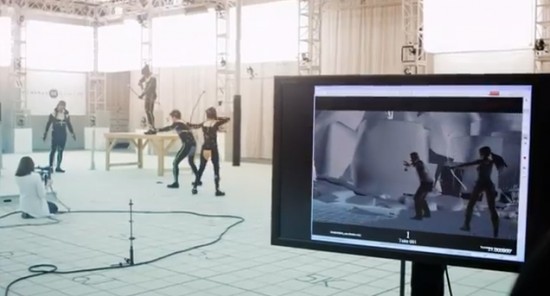This week I
started the Motion Capture course, the first blog assignment was to choose a
game that I admire that uses Motion Capture. I have chosen the latest game from
one of my favourite game series of all times – Tomb Raider (2013).
For
capturing body movement Tomb Raider uses a Passive Optical Motion Capture where
the actors wear suits with lots of reflective markers on them. For the facial
expressions they use MotionScan where the face is covered in a fluorescent paint
called MOVA. I also found an article saying that they used an in-house XSens
suit (Inertial Motion Capture).
The Motion
Capture of Tomb Raider was recorded at Digital Domain in Los Angeles, which is
a huge studio with the possibility of using several actors simultaneously; at
the most I could see four actors on the set at the same time (picture below).
The videos
I found from the Motion Capture Studio with the actress, only shows that it was
used for cutscenes although the article I found said that the XSens suit was used
for in-game motion capture.
For the
role of Lara Croft the developers hired an actress that they felt could
personalize the character and make her seem like a realistic person. The
actress finally chosen (Camilla Luddington) was one of hundreds of actresses that
were considered. There are similarities between the actress and the character,
but the character is not a replica of the actress. Mostly it is the hair colour
that is similar while facial features vary in likeness.
They used the
actress for all movement, facial and vocal captions. As far as I can see from
the video material they only captured general body movement and not fingers,
although weapons used were also motion captured.
It was not
very easy to find a lot of information about the use of motion captures I
thought, but from what I could find; one of the most prominent reasons for
using Motion Capture was to use an actress that they felt personified the Lara Croft
that they wanted to portray in the story.
Both Square
Enix and Crystal Dynamics use Motion Capture and both of them have technologies
in-house.
I chose the
game because the game series is probably my favourite one of all games I have played;
I truly appreciate the realism, both in artwork and movement, and style of the
game. I really liked how the developers managed to convey a personality and
story. It is what they wanted to achieve by using the various Motion Capture
techniques and I think that it worked well.
I did not
know before whether Motion Capture was used or not when creating the game and I
would not have thought of so many different varieties of Motion Capture being
used. I did not before yesterday even know that they existed. I have learnt how
important having a good actor can be and how that can be used to get a more
realistic result than using traditional animations. This is because actors have
trained to express emotion with their bodies and faces that an animator might
not have.
What I did
like the most about the animations in the game was probably how it showed
personality and emotion. It has been quite a while since I played the game so I
cannot really remember what I liked the least about the animations. The only
thing I can think of was that at times they seemed a bit “rubbery” almost, not
as explosive as real human movement, as If lacking strength in the muscles.
I had read
about how they wanted to humanise Lara before playing the game and I think that
they managed to do so. They used the Motion Capture techniques available to
create this result with the help of a real actress, when watching the video
material, the size of their budget was very obvious. It was really interesting
to see a little of how the game was done and very inspiring as a game like this
would be my dream project to work with.
Sources:






Inga kommentarer:
Skicka en kommentar